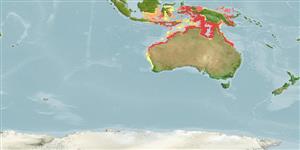Environment: milieu / climate zone / depth range / distribution range
Ökologie
seewasser demersal; ozeanodrom; tiefenbereich 0 - 36 m, usually ? - 36 m (Ref. 6205). Tropical; 0°S - 35°S, 111°E - 150°E (Ref. 6205)
Western Central Pacific: Indonesia, southern New Guinea and northern Australia. Frequently confused with Sillago maculata which occurs in eastern Australia.
Length at first maturity / Size / Gewicht / Alter
Maturity: Lm 13.4, range 13 - 13.9 cm
Max length : 36.0 cm SL Männchen/unbestimmt; (Ref. 6205)
Rückenflossenstacheln (insgesamt): 12; Rückenflossenweichstrahlen (insgesamt): 19-21; Afterflossenstacheln 2; Afterflossenweichstrahlen: 18 - 20; Wirbelzahl: 34 - 36. Swim bladder with four anterolateral extensions that are more complex than S. aeolus, but much shorter than S. maculata. Body coloration is very similar to S. maculata and S. aeolus. Body with oblique bars which are not joined as in S. maculata. The upper blotches are small, the black spot at the base of the pectoral fin is indistinct. The lateral silvery stripe is noticeable but may be quite faded.
Most abundant on silty-sand or muddy substrates. Large adults feed near gutters and sandbars inside Shark Bay and move into deeper waters of marine embayments. Juveniles frequent seaweed banks and broken bottom and occur in large numbers near mangrove creeks. They enter coastal rivers in the Swan and Mandurah estuaries in western Australia. Oviparous (Ref. 205), and are multiple spawners with synchronous development (Ref. 36823). Juveniles and adults are commonly trawled with S. robusta and S. lutea (Ref. 6205). Marketed fresh (Ref. 9679).
Multiple spawners with synchronous development (Ref. 36823).
McKay, R.J., 1992. FAO Species Catalogue. Vol. 14. Sillaginid fishes of the world (family Sillaginidae). An annotated and illustrated catalogue of the sillago, smelt or Indo-Pacific whiting species known to date. Rome: FAO. FAO Fish. Synop. 125(14):87p. (Ref. 6205)
IUCN Rote Liste Status (Ref. 130435)
Bedrohung für Menschen
Harmless
Nutzung durch Menschen
Fischereien: weniger kommerziell
Mehr Information
ReferenzenAquakulturAquakultur ProfilZuchtlinienGenetikElectrophoresesVererbbarkeitKrankheitenVerarbeitungNutrientsMass conversion
PartnerBilderStamps, Coins Misc.LauteCiguateraGeschwindigkeitSchwimmstilKiemenoberflächeOtolithsGehirngrößeSehfähigkeit
Tools
Zusatzinformationen
Download XML
Internet Quellen
Estimates based on models
Preferred temperature (Ref.
123201): 25.8 - 28.7, mean 27.7 °C (based on 550 cells).
Phylogenetic diversity index (Ref.
82804): PD
50 = 0.5000 [Uniqueness, from 0.5 = low to 2.0 = high].
Bayesian length-weight: a=0.00851 (0.00366 - 0.01979), b=3.07 (2.86 - 3.28), in cm total length, based on LWR estimates for this (Sub)family-body shape (Ref.
93245).
Trophic level (Ref.
69278): 3.3 ±0.2 se; based on diet studies.
Widerstandsfähigkeit (Ref.
120179): mittel, Verdopplung der Population dauert 1,4 - 4,4 Jahre. (Preliminary K or Fecundity.).
Fishing Vulnerability (Ref.
59153): Low to moderate vulnerability (34 of 100).
